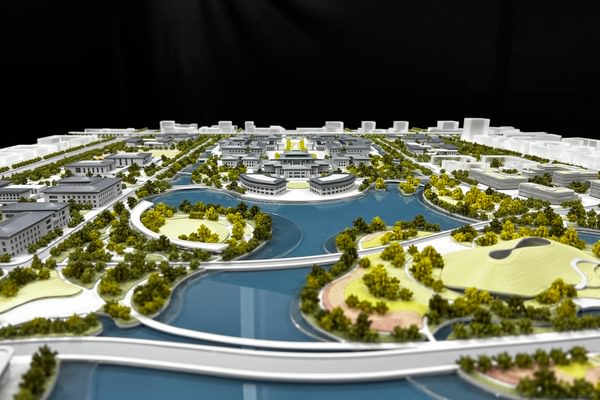
Concept design for Peking Union Medical College
The Tianjin Campus of Peking Union Medical College is a project of real historical importance. Our masterplan and architectural design for the campus will be in two phases, with phase one covering 466,000 sqm and phase two, 483,500 sqm.
Our designs create an environment for medical education that will inspire learning, thinking and communication. This vibrant, futuristic, garden-like campus will incorporate efficient transportation networks and become a truly diverse place to live, study and work.
The building heights of each plot are carefully planned to create a varied urban skyline. In the first phase, the higher education zone will be created to include the main teaching buildings on the campus and the sports hall. The ‘concord nave’ will be the highest point, becoming a landmark of the whole site. The overall campus facade has a modern interpretation of the century-old famous school by expressing its classical architectural style in a progressive new way.
The college cluster introduces the concept of an ‘academic circle’ and academic squares connect each college, providing a place for interdisciplinary exchanges. The academy cluster emphasises independence.
The second and third phases include building an International Exchange Centre, R&D Centre and workplace and commercial units. The long-term planning strategy is to integrate the campus with the surrounding businesses and hotels and offices.
There will be a campus landscape water system which, combined with large-scale green spaces such as Tuanbo Lake Wetland Park, will enhance wetland water purification. On and around the buildings, infrastructure such as roof gardens and permeable pavements will be built to improve the ecological coverage and rainwater storage capacity of the campus. Waterfront spaces will be connected to activity spaces and a multi-level walking system will be incorporated, including paths for walking and jogging and a pedestrian bridge to make different areas of the campus accessible to all.
The plan fully respects the nature of the site, respects its history and integrates the city with its scenery.
Our designs create an environment for medical education that will inspire learning, thinking and communication. This vibrant, futuristic, garden-like campus will incorporate efficient transportation networks and become a truly diverse place to live, study and work.
The building heights of each plot are carefully planned to create a varied urban skyline. In the first phase, the higher education zone will be created to include the main teaching buildings on the campus and the sports hall. The ‘concord nave’ will be the highest point, becoming a landmark of the whole site. The overall campus facade has a modern interpretation of the century-old famous school by expressing its classical architectural style in a progressive new way.
The college cluster introduces the concept of an ‘academic circle’ and academic squares connect each college, providing a place for interdisciplinary exchanges. The academy cluster emphasises independence.
The second and third phases include building an International Exchange Centre, R&D Centre and workplace and commercial units. The long-term planning strategy is to integrate the campus with the surrounding businesses and hotels and offices.
There will be a campus landscape water system which, combined with large-scale green spaces such as Tuanbo Lake Wetland Park, will enhance wetland water purification. On and around the buildings, infrastructure such as roof gardens and permeable pavements will be built to improve the ecological coverage and rainwater storage capacity of the campus. Waterfront spaces will be connected to activity spaces and a multi-level walking system will be incorporated, including paths for walking and jogging and a pedestrian bridge to make different areas of the campus accessible to all.
The plan fully respects the nature of the site, respects its history and integrates the city with its scenery.




